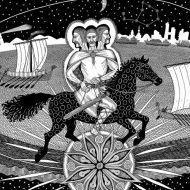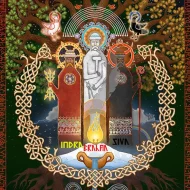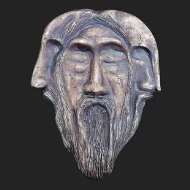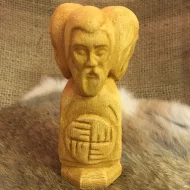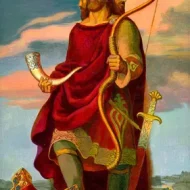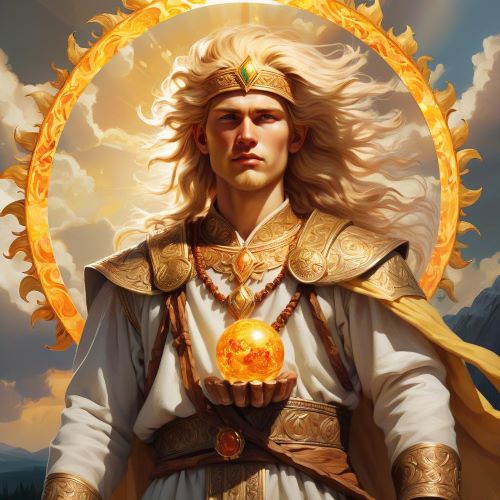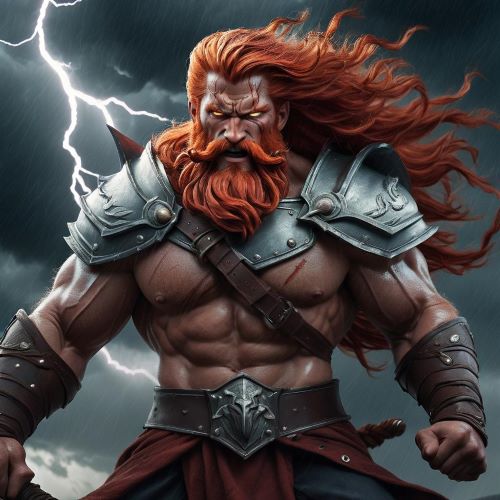Triglav : The Three Headed God
Listen
At a glance
| Description | |
|---|---|
| Origin | Slavic Mythology |
| Classification | Gods |
| Family Members | N/A |
| Region | Poland, Romania |
| Associated With | Divination |
Triglav
Introduction
Held in deep reverence by the ancient Slavs, Triglav, the god of three heads, occupies a distinctive and singular role within the pantheon of deities in the region. His multifaceted nature, aptly represented by his trio of heads, serves as a profound reflection of the intricacies within the Slavic belief system. As a deity of great complexity, Triglav encompasses a multitude of aspects in the natural world, embodying the interconnectedness between heaven, earth, and the underworld. His origin story and the tales that chronicle his exploits offer profound insights into the profound beliefs and enduring values held by the Slavic people.
Physical Traits
A defining characteristic that distinguishes Triglav is its unique portrayal featuring three heads. These heads, at times resembling either goat-like visages or human countenances, each bear the symbolism of distinct realms of existence or divine powers intimately associated with Triglav. This captivating representation carries profound cosmological and spiritual significance within the realm of Slavic mythology.
The initial head is that of a young man, embodying the essence of youth, the promise of growth, and the rejuvenation of spring. The second head, characterized by the visage of a mature adult, conveys the attributes of wisdom, strength, and the abundant warmth of summer. Lastly, the third head takes the form of an elderly man, serving as a symbol of the wisdom that accompanies old age and the gentle decline of autumn. This trinity of heads collectively encapsulates the cyclical nature of life and the pivotal role of changing seasons, aspects of paramount importance within the ancient Slavic agricultural societies.
Triglav’s physical form is often depicted as robust and muscular, a testament to his profound connection with the earth and its intrinsic fertility. Adorned with a variety of symbolic elements, he frequently bears oak leaves, emblematic of strength and endurance. Draped in a necklace of serpents, these creatures symbolize the perpetual cycle of life and death. Furthermore, Triglav may be portrayed holding various objects in his hands, including a staff, a sickle, or a sheaf of grain, all of which are inextricably linked to agriculture and the ever-turning wheel of seasons.
Family
Triglav’s mythological affiliations with other Slavic deities serve to accentuate its significance and shed light on its intricate essence. Spanning across various Slavic regions, Triglav’s interactions with gods such as Perun, Svarog, and Veles, to name a few, unravel a complex tapestry of divine relationships, thus emphasizing the god’s multifaceted role within the pantheon.
Triglav’s familial bonds are equally intricate, entwining with other Slavic deities. He is frequently regarded as a member of the extended family of Veles, a deity closely linked with domains such as cattle, commerce, and the underworld. In certain interpretations, Triglav is even portrayed as the progeny of Veles, symbolizing the profound connection between the seasons and the eternal cycles of life and death, while preserving the natural order.
Triglav’s associations with other gods extend beyond Veles, intertwining with Dazhbog, the sun god, who is often depicted as his sibling. This connection symbolizes the harmonious interplay between light and darkness, day and night, and the perpetual shift of seasons. Together, they harmonize the equilibrium of the natural world.
Other names
Within Latin records, this divine name is documented as Triglau, Trigelaw, Trigelau, Triglou, Triglaff, and Trigeloff. Notably, the appellation “Triglav” directly translates to “the one with three heads.”
Powers and Abilities
Triglav’s powers and abilities are as diverse as his names and physical forms. As a god of the changing seasons, he possesses the ability to influence the climate, fertility of the land, and the success of agricultural endeavors. In the spring, he ushers in the warmth and the growth of crops, while in the summer, he ensures bountiful harvests. During the autumn, Triglav oversees the gathering of the crops and the preparation for the harsh winter. His three heads symbolize his control over the transitions between these seasons and his role in the cyclical process of life, death, and rebirth. Additionally, Triglav is believed to have the power to shape-shift, allowing him to move between his various forms and to interact with humans and other deities. This transformative ability underscores his connection to the natural world and the ever-changing cycles of life.
Modern Day Influence
In contemporary times, the enduring legacy of Triglav continues to reverberate throughout Slavic cultures and has permeated various facets of modern society. While the veneration of ancient Slavic deities has largely yielded to alternative belief systems, Triglav’s symbolism perseveres as a steadfast cultural icon. His imagery, underlining the cyclical essence of existence, remains an integral component of Slavic folklore and traditions.
A particularly noteworthy manifestation of Triglav’s influence can be observed in the observance of Maslenitsa, a Slavic festival that heralds the end of winter and the advent of spring. During this festive occasion, a straw effigy known as “Lady Maslenitsa” is meticulously fashioned to symbolize the departure of winter. In select Slavic regions, Lady Maslenitsa is adorned with a distinctive headdress featuring three heads, reminiscent of Triglav’s iconic visage. The ritualistic burning of this effigy during the celebration serves as a poignant metaphor for the transition from the cold grip of winter to the rejuvenating embrace of spring, mirroring Triglav’s pivotal role in the cyclical progression of seasons.
Furthermore, the tripartite symbolism of Triglav’s three heads is frequently employed as a representation of the past, present, and future in various Slavic artistic expressions, literature, and folklore. This concept serves as a poignant reminder of the perpetual cycle of life and underscores the imperative of embracing change and growth, perennially resonating with the Slavic consciousness.
Related Images
Frequently Asked Questions
What is lorem Ipsum?
I am text block. Click edit button to change this text. Lorem ipsum dolor sit amet, consectetur adipiscing elit. Ut elit tellus, luctus nec ullamcorper mattis, pulvinar dapibus leo.
What is lorem Ipsum?
I am text block. Click edit button to change this text. Lorem ipsum dolor sit amet, consectetur adipiscing elit. Ut elit tellus, luctus nec ullamcorper mattis, pulvinar dapibus leo.
What is lorem Ipsum?
I am text block. Click edit button to change this text. Lorem ipsum dolor sit amet, consectetur adipiscing elit. Ut elit tellus, luctus nec ullamcorper mattis, pulvinar dapibus leo.
What is lorem Ipsum?
I am text block. Click edit button to change this text. Lorem ipsum dolor sit amet, consectetur adipiscing elit. Ut elit tellus, luctus nec ullamcorper mattis, pulvinar dapibus leo.
What is lorem Ipsum?
I am text block. Click edit button to change this text. Lorem ipsum dolor sit amet, consectetur adipiscing elit. Ut elit tellus, luctus nec ullamcorper mattis, pulvinar dapibus leo.

